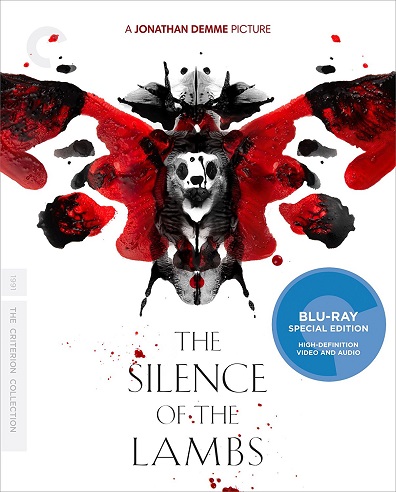
The Silence of the Lambs
Studio: Criterion
Feb 16, 2018
Web Exclusive
![]()
There are two great pieces that articulate the best words to be written on Jonathan Demme’s The Silence of the Lambs: Willow Maclay writes, regarding Buffalo Bill’s gender identity,
“If Bill is a trans woman then The Silence of the Lambs’ feminist intentions are damned to a degree, but there’s something within the characterization of Bill that strikes me as sympathetic rather than truly vile. He is very obviously a monster, but he has looked for help in the only way he knew how to by seeking psychiatric counseling and gendered medical transition before being denied for both. Was he driven towards these actions by society’s misunderstanding of transgender bodies or was he always evil?”
And Rani Baker meditates on the film’s Manichean queerness, arguing,
“And even as Ted Levine’s lumbering, gangly tr*nny monster performance is frequently superimposed over depictions of the lives of trans folks, and the spectre of which haunts discussions of everything from ‘bathroom bills’ to TSA clearances, Lecter represents the opposite of this stereotype. Lecter is theatrical without camp. He is effette but not effeminate. He drips with sarcasm and is impeccably refined and cultural and worldly. [...] This sort of gatekeeping, this arbitration of judgement over folks less desirable is clearly the role the unexamined audience wants from Lecter. He returns to this role over and over and over, evolving from a useful monster to a justified protagonist in his own universe, while his gruesome body count silently grows.”
In addition to the words from Maclay and Baker, Jos Truitt makes the excellent case that The Silence of the Lambs’ feminism—its “woman in the face of patriarchy and male violence”—is reserved for cis women. Even scholar Carol J. Clover recognized this in her book Men, Women, and Chain Saws: Gender in the Modern Horror Film.
I, writing as a cis guy, will continue to reconcile my interest, admiration, and adoration with this ever-transmisogynistic piece of art. I recognize I have the privlege of not being the target of the film’s sore spots, inaccuracies, and vilifications.
Forgive the confirmation bias, but Maclay’s words strike me in how she examines Jonathan Demme and cinematographer Tak Fujimoto’s aesthetic decisions, even if they vindicate Truitt’s argument. Buffalo Bill’s presentation as a character with a persona is so fragmented—split between the numerous real-life killers that inspired them, in addition to the trans element—that however evil they’re supposed to be, there is something palpably heartbroken about the proceedings. With age, the “tucking” scene, in which Buffalo Bill paints on a face and attempts to spread their wings, reads to me (a cis person) not solely as monstrous, but very sad, full of frustration and sadness about the limitations of the corporeality of perceived gender and the way it feels like entrapment, this tone augmented by Ted Levine’s performance. Lecter’s (Anthony Hopkins) dismissal and gatekeeping of queerness also invokes empathy in me for Jame Gumb.
Though it may be a stretch, the horror of The Silence of the Lambs to me is not Jame Gumb but systematic misogyny and queerphobia. While Clarice Starling (Jodi Foster) spends a majority of the film justifying her own intellectual prowess to men (straight and queer-coded alike), Demme (and screenwriter Ted Tally) insert hints as to Jame Gumb’s background, enough to suggest (however inaccurately) that they have faced an unending amount of abuse and trauma. Pathologizing the character is, by all means, incorrect, but a hallmark of Demme’s oeuvre was his humanism, and Demme, though very much an outsider looking in, extends sympathy to Gumb.
The packaging artwork of the new edition of the film released by The Criterion Collection created by Sean Freeman and Eve Steben, collectively known as THERE IS, suggests that there was also beauty behind the supposed monstrosity. With red and black ink, the artists have designed a cover that mimics the film’s original iconography of the death’s head moth, twisting it so that it also looks like a Rorschach test, or an ink blot, spattered with blood. It’s an entrancing cover, perhaps the best Criterion has ever commissioned, able to be faithful to the film’s spirit but also unlock something that has frequently been rewritten about its emotional core. There is, in this art, an enigma that many of us assume we understand. The cover art may diagnose precisely the problem with the film’s cis male characters and of its, or our, system: the unknowable beauty and sadness of womanhood in the real world.
www.criterion.com/films/528-the-silence-of-the-lambs
Current Issue

Issue #72
Apr 19, 2024 Issue #72 - The ‘90s Issue with The Cardigans and Thurston Moore
Most Recent
- Maggie Rogers @ House Of Blues, Chicago, US, April 19, 2024 (Review) —
- 10 Best Songs of the Week: Nilüfer Yanya, Linn Koch-Emmery, Fat Dog, Crumb, St. Vincent, and More (News) —
- Fat Dog Announce New Album and Tour, Share Video for New Song “Running” (News) —
- The Obsessed, Howling Giant @ Brooklyn Meadows, NYC, April 12, 2024 (Review) —
- Premiere: Slow Joy Releases New Single and Video for “King Cowboy” (News) —

Comments
Submit your comment
June 8th 2019
12:44am
Fix connection to bluetooth audio device and wirelesses displays in windows 10,this is common issue,now today we will be learn how can do i connect the wireless device.